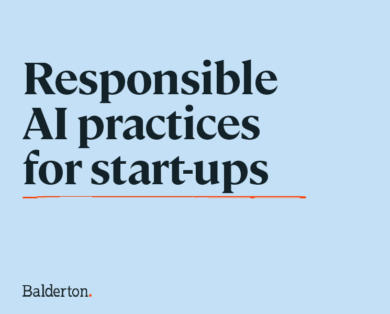- 15 January, 2025
This article on establishing a patent strategy is brought to you by Balderton’s Executives in Residence Dan Teodosiu, Dave Kellogg and Andrew Wigfall.
Why you should read this article
Patents are critical for most companies. However, in most startups, patents are ignored, underdiscussed, and misunderstood, leading to core inventions left unprotected and/or the company left unarmed when the need to defend itself against a competitor arises.
If you’re a founder, executive, or senior tech person in a startup, the purpose of this article is to provide you with enough knowledge of patents to help you understand why your startup needs a patent strategy, to encourage you to start devising your company’s patent strategy, and to suggest next steps you can take now to get the process started.
In this article we will cover the basics, mostly as they apply to software startups. To go further, you should hire a patent attorney to help you drive the process and peruse the ample introductory literature available on the web to ensure your interactions with your lawyers are productive.
Why file patents?
Let’s start with two stories illustrating the importance of patents in two different uses.
Bill and Steve’s brief visit to Sun Microsystems
Bill Gates and Steve Ballmer [had] flown in over a weekend to meet with Scott McNealy, Sun’s then-CEO […]. As we sat down in our Menlo Park conference room, Bill skipped the small talk, and went straight to the point, “Microsoft owns the office productivity market, and our patents read all over OpenOffice. […] We’re happy to get you under license.” That was code for “We’ll go away if you pay us a royalty for every download” – the digital version of a protection racket.
But fearing this was on the agenda, we were prepared for the meeting. […] “We’ve looked at .NET, and you’re trampling all over a huge number of Java patents. So what will you pay us for every copy of Windows?” Bill explained the software business was all about building variable revenue streams from a fixed engineering cost base, so royalties didn’t fit with their model… which is to say, it was a short meeting.
The above story is paraphrased from Jonathan Schwartz (Sun Microsystems’ former CEO) and illustrates the defensive role of patents, where patents can be used as bargaining chips if a competitor threatens you.
The next story shows an offensive use of patents that allows you to collect royalties on your intellectual property that other companies want to use, potentially generating significant royalty streams for decades.
The little file system that could
As late as the 2010s, Microsoft was estimated to make $5 to $15 on royalties for every Android device sold, including royalties from their FAT filesystem patents, filed in the mid 1990s. That amounted to $2B per year for Microsoft, and possibly more.
Although one of the FAT patents got struck down in Germany in 2013, not all of this royalty income dried up. To this day, Microsoft still receives royalties on exFAT, a file system format to support very large volumes or file sizes, from companies that are not OIN members. This is incidentally one of the reasons why exFAT support is not very widespread in consumer devices.
Why does your startup need patents?
If your startup has invented a new software-based way of solving a problem, you should consider patenting it. Patents are designed to protect inventors and companies, and to reward them for the work required to create inventions by either preventing others from using them or requiring others negotiate a licence fee to do so.
That brick-type container that holds your almond milk? Patented. The cap on that container? Patented, as well. Closer to home in technology, the semantic layer that propelled Business Objects to its $7B sale to SAP? Patented. More contemporarily, the method ZOE uses to personalise nutritional recommendations using biomarkers – the bread and butter of their business? Patented as well.
The primary use of patents for startups is to protect their core inventions. As companies grow larger, they may start developing larger patent portfolios including patents that are not necessarily core to their business, but that may be useful as a defensive measure against attacks. Very large companies often simply “flood the zone” – e.g., as of 2024, Microsoft and IBM hold over 107K and 122K patents, respectively.
The patent landscape resembles an uncomfortable stalemate where most companies are sufficiently armed to dissuade their competitors from attacking them.
A quick introduction to patents
Intellectual property 101
Patents are part of a broader field known as intellectual property (IP) which also includes trade secrets, trademarks, and copyrights.
Trade secrets are confidential information (e.g., plans, know-how) that companies want to protect from disclosure, typically via confidentiality clauses in employment contracts, non-disclosure agreements (NDAs), and commercial contracts. Trademarks protect brand names, imagery, and slogans (e.g., the Pepsi logo, the word Kleenex, and the McDonald’s slogan, I’m Lovin’ It). Copyrights protect creative works such as movies or music, or in the tech industry, source code.
Patents protect inventions – for example, devices, methods, compositions, ideas or processes.
The word patent originates from the Latin patere, which means to “lay open” or make available for public inspection. A patent includes two main parts:
► A description of the invention that provides sufficient detail to allow any person skilled in the art (i.e., competent in that particular technical field) to implement and use the invention.
► A set of claims that define the scope of the IP protection that the patent provides. The claims must be based on the description and are the only aspects of the IP protected by the patent, meaning that if the description contains information about IP not covered by the claims, then that IP is not protected by the patent.
It’s important to note that the ultimate value of a patent doesn’t reside in being granted, but in being able to prevail in patent litigation. Or better yet, in avoiding such litigation by negotiating an appropriate royalty from those using your inventions, or deterring would-be claims against you when others consider the impact of the counter-claims they may face from your patent portfolio.
When to patent?
When it comes to timing, there are two things to remember about patents:
► You should file a patent application before any public disclosure of the invention you’d like to protect. Public disclosure can mean shipping a product based on that IP (especially if there’s an externally visible manifestation of it), publishing a paper, or disclosing the IP to anyone without having an NDA in place. While you may still file a patent after public disclosure in some cases, the “grace period” varies by geography. In the EU you can’t file an application at all once you’ve disclosed the invention, while in the US you have up to one year to file after public disclosure.
► Patent applications are considered by the date of filing, not the date of invention. While there is much mythology about the race to the patent office between Alexander Graham Bell and Elisha Gray for the original telephone patent, at the time the US was on a first-to-invent, not a first-to-file, priority system. But as of March 2013, the US joined the rest of the world on a first-to-file system. One pathological case created by this is that a competitor can beat you to the patent office on your invention as a result of your inadvertent public disclosure.
How to make your patents easier to enforce?
When patenting an invention, you may want to include at least some externally visible aspect, even if the invention mostly involves an internal approach. “Externally visible” aspects may include those related to the UI, but also APIs or interchange data formats (e.g., the FAT file system format). Doing so can make it easier to enforce your patent later.
As an example, if your startup is providing a job marketplace and you patent your novel software that matches job seekers to employers, ideally you may want to include a UI aspect that is specific to your approach. For example, this may be a way of representing in the UI the multi-dimensional match score your software produces.
Patenting purely internal approaches makes proving infringement by a competitor difficult, especially for SaaS companies. In the above example, if you only patent the matching software without the UI aspects, you would not be able to easily prove infringement without access to your competitor’s source code.
Where to patent?
You should consider filing patent applications in the main geographies where your startup is active or may be active in the future. Typically, you would consider filing in the US and the EU, or go through the PCT (Patent Cooperation Treaty) route to seek protection in a large number of countries. Ask your patent attorney for advice on the best cost-benefit tradeoff.
Your startup needs a patent strategy now
What’s a patent strategy, and why do you need one?
A patent strategy helps you answer the following questions:
► What is the core IP that your company should protect?
► What is the threshold for an idea or innovation to be considered core?
► How are you going to prepare defensively, i.e., to be ready to defend possible infringement cases against you?
► How much money and time should you spend on patents?
You need one for the following reasons:
► To make sure that you don’t end up in a situation where you have no way to protect your core IP.
► To focus the effort on patenting the IP that really matters for your business and avoid overzealous patent lawyers driving billings or misguided boards telling you to “patent more stuff.”
► To get a sense of security, knowing that you have control over your critical IP.
► To be able to plan a patent budget and spend it in an effective way. You don’t want to spend significant time and a fortune on patents that are useless.
There are a number of things that you need to have internal clarity on to articulate your patent strategy:
► Strategic intent of the patents: do you see them as offensive or defensive? For the former, you want to adopt a focused strategy around your core IP; for the latter, a broader approach is likely more appropriate so that you can respond to attacks across a wider range of areas.
► Enforcement strategy. How aggressively do you wish to enforce your patents? What are the anticipated responses to your enforcement attempts?
► Rough number of patents and, implicitly, budget. You’ll want to focus on your core IP patents first, and, if you have appetite, add important but non-core ones later.
► Monitoring your competitors: understanding the degree to which your competitors are coming close to infringing on your IP, and how litigious the ecosystem currently is or may become in the future. Note that in the US you will need to establish a patent reading policy to avoid potential enhanced damages related to willful infringement, a topic best discussed with your attorneys.
Once you have your patent strategy in place you should be able to evaluate your IP on a continuous basis and decide whether any given invention is part of your core IP, and thus whether you should consider patenting it. This includes existing IP that has not already been publicly disclosed (subject to aforementioned grace periods), and new IP as it is being created.
Some open source startups think that patent strategy does not apply to them. But for open core companies, where there is an open source core surrounded by proprietary extensions, that’s not necessarily true since you may have core IP in the closed source offering, and you should consider protecting that as would any software company.
Defining your patent strategy
The right time for most startups to put in place a patent strategy is yesterday: because you need to file prior to disclosure, delaying your patent strategy means that you may miss the window of opportunity to protect some of your core inventions.
Defining patent strategy can be a difficult task if you’re a pre-PMF startup that’s focused on reaching PMF before wanting to spend time on anything else. Additionally, it may not even be clear pre-PMF which of your IP is going to be core for the post-PMF product, e.g. if you need to pivot to reach PMF. Nevertheless, it’s best to use your intuition and impose the self discipline to think about patents early because once you “have the time” to do it, it may be too late.
It’s important to pick a law firm early that will help you define your patent strategy, file patents, and represent you in any patent litigation. We highly recommend picking a law firm that is well versed in filing international patents, and has experience with IP litigation in your space. This last point is quite important, as the true strength of a patent can only be tested during litigation, i.e. even if you have been granted a patent, there is always a risk that it could get struck down in court. IP litigation is a highly specialised area of law and your choice of firm to represent you could easily carry a lot of weight with the counterparty and its counsel in any threatened or actual litigation proceedings. Choosing a well-known firm, as opposed to being represented by someone who is a good all round general purpose litigator but is not known for IP litigation, is really important. Many corporate law firms do not have leading IP litigation practices, and if your corporate law firm does not, they should be able to help you find a suitable expert.
To define your patent strategy you will need to involve the following parties:
► The CTO, CPO, and senior engineers and Product Managers who will be able to draw up and evaluate potentially patentable IP to determine whether it meets the core IP bar.
► The CEO and/or senior executives, who will provide input on intended usage of your future patents, as well as the budget that they would like to allocate. Sometimes one of the senior executives can act as a sponsor of the patenting activity.
► Your General Counsel (if you have one) and patent lawyers, who will be able to suggest how aggressive a strategy you should use.
Step zero is getting everyone to understand the basics and the framework. Once they get the concepts behind the patent strategy (and have read this article), you should be able to make progress relatively quickly.
The main point however is not about how quickly you can define your patent strategy. It’s that you should create one. While earlier is generally better than later, it’s never too late to create a patent strategy and it’s always better to have one than not.
You may want to re-evaluate your patent strategy on a yearly basis to take into account any changes in the competitive landscape, any recent inventions, any patent litigation activity in your space, and your appetite for defending your core IP.
Conclusion
Putting in place a patent strategy and starting to build a patent portfolio is an important way to defend your startup’s core IP and to protect yourself from litigation by competitors. Carving out time and budget for this from the hectic schedule and the cash constraints of a startup requires self-discipline.
Doing this as early as possible, prior to the public disclosure of your core IP, ensures that you can get maximum protection of your startup’s inventions. While you may not see any immediate benefits, a patent portfolio can make a significant difference to your business, and to your company’s value, as your business grows over time.












